Journey Into the Sun:
California Artists and Surrealism
Susan M Anderson
Reminiscing about the 1940s, which he spent in Hollywood, the artist Man Ray said, "There was more Surrealism rampant in Hollywood than all the Surrealists could invent in a lifetime."[1] The peculiar and pervasive fantasy of Los Angeles, its illusion and promise of fame, made the city surrealist by nature. European dada and surrealist artists who visited California during the 1930s and 1940s felt both strangely at home and like fish out of water.
The international artistic movement most shaken by the events of World War II was surrealism. The war scattered the European surrealists and effectively ended the formal movement. Many of these artists subsequently passed through California; some decided to stay and make the state their home, at least for a while. Among the transients were Fernand Léger, Max Ernst, Marc Chagall, Roberto Matta, and Wolfgang Paalen. Besides Man Ray, others who spent considerable time in the state were Salvador Dalí, who invigorated the art scene on the Monterey Peninsula for several years; Hilaire Hiler, who lived in the Bay Area; and Gordon Onslow-Ford, who has resided in Northern California since 1947. These artists became conduits for the transmission of surrealist thought. The legacy they left behind in California is still being explored.
The quest for absolute freedom central to surrealism was also a hallmark of the California Dream. During the 1930s and 1940s artistic freedom was simultaneously real and paradoxical on the West Coast, where there were few long-standing social conventions, artistic traditions, or institutions to provoke rebellion. Artistic production at the time received its main stimulus in San Francisco from art schools and museums and in Los Angeles from a handful of well-managed private galleries.
The West Coast dealer Howard Putzel, together with the New York dealer Julian Levy, organized several shows of European surrealism in Los Angeles and the Bay Area in the mid to late 1930s at the Howard Putzel, Courvoisier, East West, and Paul Elder galleries. Stanley Rose's Centaur Gallery and Frederick Kann's Circle Gallery in Hollywood were also important venues. In the late 1940s Copley Galleries in Los Angeles,
run by the painter William Copley, showed the work of René Magritte, Joseph Cornell, Yves Tanguy, Man Ray, Matta, and Ernst. The Modern Institute of Art, started by the artist Frederick Kann, the actor Vincent Price, and others in 1947, exhibited Ernst, Klee, and Miró during its two years of existence.
San Francisco artists had little firsthand experience of advanced forms of modern art until 1935, with the opening of the San Francisco Museum of Art, directed by the forward-thinking Grace McCann Morley. Morley brought to San Francisco several of the exhibitions that New York's Museum of Modern Art organized under Alfred Barr, including, in 1937, Fantastic Art, Dada, and Surrealism , which led many Bay Area artists to experiment with surrealism.[2]
The only organized response to European surrealism in the United States emerged in Los Angeles in the 1930s, before the refugee European surrealists had arrived. Instigated in 1934 by Lorser Feitelson and Helen Lundeberg, Post-Surrealism, really an American critique of European surrealism, was deeply rooted in the social reality of 1930s America. Critics and artists were searching then for a truly American style, and there was a suspicion of experimentation and European influence. Post-Surrealism, however, succeeded in awakening an interest in surrealist models in the United States; it had far-reaching implications in the history of California art.
California underwent dramatic transformations when war broke out in Europe. The state was propelled into a war economy even prior to U.S. engagement, making Los Angeles and San Francisco major industrial as well as population centers. When California artists were called upon to turn their efforts toward the war, the nativist concerns of the American Scene school lost their grip on California art as well as on the American public. In the early years of the war European surrealism became an important stimulus.
The war acted as a powerful energizing force and as an agent for change, transforming regional artistic models and opening the way for new art forms. To portray the chaos and destruction of their world, many artists in California, now caught up in international modernist currents, chose a surrealist approach.[3] Man Ray, who lived in Los Angeles during the 1940s, inspired the experimentation in new genres and the crossover of popular culture and high art. Hans Burkhardt, Eugene Berman, and Rico Lebrun disseminated an expressionistic, abstract surrealism invoking war's disequilibrium. Charles Howard, who in 1940 returned to the Bay Area from London, introduced to the state an organic, abstract surrealism with the expressive emotional power of the sublime that reflected the spiritual temper of the time. Statewide few artists were well versed in the principles of automatism, however, and consequently they adopted the formal elements of surrealism rather than its methodology or intellectual tenets.
At the close of World War II the interest in international modernism intensified. Artists carried forward the spirit of surrealism and dada, adapting it to the urgencies of the postwar era. They spiritually embraced and visually articulated the rhetoric of the 1930s expressing the need to create a truly American art, but this time within a more
radical framework. European surrealism invigorated postwar American art and helped give birth to abstract expressionism.
The late 1940s marked the beginning of an era of intense experimentation in the San Francisco Bay Area. Beat poets, photographers, filmmakers, assemblage artists, figurative artists, and abstract expressionists would soon coexist and nourish each other. The postsurrealist Dynaton movement, created by the Austrian Wolfgang Paalen, the American Lee Mullican, and the Englishman Gordon Onslow-Ford, added to this incredibly complex artistic mix by awakening interest in Jungian psychology, esotericism, the nonrational, and the new physics. Surrealist ideas were "in the air," making possible an extraordinary diversity of inflection.
Post-Surrealism and the Flux: Lorser Feitelson, Helen Lundeberg, and Knud Merrild
Artistic activity in California during the 1930s and 1940s was a process of reciprocity and encounter between artists of many regions and many nationalities. Art thrives on such mixing, clashing, cross-fertilization, and critical difference. European surrealism blended with indigenous styles, enriching regional art and creating interesting hybrids.[4] One example of this crossbreeding is the Post-Surrealism inaugurated in 1934 by the Los Angeles artists Helen Lundeberg and Lorser Feitelson. Post-Surrealism differed radically from surrealism in affirming a conscious rather than unconscious use of materials and the clarification of rational ideas. It maintained a distinct identity, reflecting and invigorating the locale of its birth.
Lorser Feitelson, educated in New York, came to Southern California in 1927; he was to be one of the most influential pioneers of modern art in the region. In the early 1920s Feitelson had visited Paris, where surrealism was incipient and neoclassicism had taken hold. It was the latter that first attracted him, along with Renaissance and Mannerist art.
In 1930 in Los Angeles, Feitelson was introduced to Walter and Louise Arensberg and their European modernist collection, which included masterworks of dada and surrealism and was a nexus for the intellectual/artistic community of Los Angeles.[5] Around this time, Feitelson started teaching at Chouinard School of Art and at the Stickney Memorial Art School in Pasadena, where he met Helen Lundeberg. Thereafter, Feitelson and Lundeberg formulated ideas that crystallized in 1934 into what they called subjective classicism, new classicism, or Post-Surrealism.
In creating their new art, Lundeberg and Feitelson grafted the neoclassicism Feitelson had picked up in Paris onto the metaphysical element he found in the paintings of de Chirico (which the Stendahl Galleries had exhibited in Los Angeles in 1930). The works that followed proclaim that connection: in their theatrical intensity, their insistence on strange encounters between objects, the clarity with which chosen fragments of reality are represented, and the depiction of deep space. But while de Chirico bathed
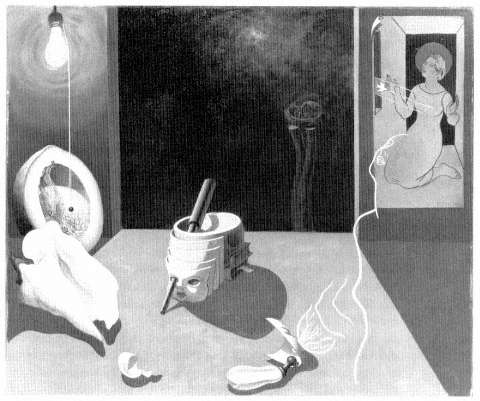
Figure 66
Lorser Feitelson, Genesis #2 , 1934. Oil on fiberboard, 40 ¼ × 47 7/8 in.
National Museum of American Art, Smithsonian Institution, museum purchase.
his enigmatic paintings in warm, late-afternoon sunlight, Feitelson and Lundeberg used pale, cool colors to create an atmosphere conducive to calm and to contemplation.
Feitelson and Lundeberg sought to create a reasoned response in the viewer that was profoundly at odds with Bretonian surrealism. Like the Belgian René Magritte, the Post-Surrealists created puzzles and told stories using objects. But while Magritte's tales were insistently unsolvable, Post-Surrealist narratives were always related to a larger theme and therefore had little to do with surrealist incongruity. Reflecting the spirit of the times, Feitelson and Lundeberg created paintings with a conscious message, an art that would be "accessible to the people." But rather than use subjects reflecting the social and political atmosphere, like artists of the American Scene, they selected metaphysical ideas, focusing on such themes as "cosmic birth."[6]
In Genesis #2 (1934; Fig. 66), Feitelson juxtaposed symbols of life forces analogous
in form and in function: an illuminated lightbulb, the half-round of a cut melon full of seeds, a large conch, an eggshell, a mask, and a female breast. He asks the viewer to contemplate the interrelationship of these differing emblems of existence, from the cosmic to the mineral. One of the most compelling features of the painting is the delicate ghostly outline of a woman superimposed over the scene, simultaneously receiving life and giving sustenance—an image expressive of the dialectic between presence and absence that initiates so much of the narrative in Post-Surrealist work.
Feitelson, a natural leader like Breton, assembled a loose circle of friends who had similar aims. Lundeberg, Knud Merrild, Lucien Labaudt, and Grace Clements were the core group, who exhibited together at the San Francisco Museum of Art in 1935 and the Brooklyn Museum in 1936. Because of the acclaim the exhibition received in New York, Feitelson, Lundeberg, and Merrild were included in Barr's exhibition Fantastic Art, Dada, and Surrealism at the Museum of Modern Art in New York.
Born in Chicago, Helen Lundeberg was raised in Pasadena, where she received her initial instruction with Feitelson at the Stickney Memorial School of Art beginning in 1930. Lundeberg began her career with exceptional technical skill and stylistic maturity: "Like Athena, she appeared on the artistic scene full-grown."[7] It was Lundeberg who wrote the manifesto of the Post-Surrealist movement.
Lundeberg was interested in a poetic contemplation of subject matter that would bring the viewer to a higher understanding of metaphysical ideas and a deeper experience of the world. Throughout her career her paintings have become increasingly more evocative and mystical. Nearly all her work is about the opening of one space into another, the juxtaposition of internal and cosmic arenas. While she did not make a study of Eastern art and philosophy while engaged in her Post-Surrealist work, she created a contemplative aesthetics of emptiness and stillness characteristic of that art. At the same time, her work showed an American predilection for definite outlines, cool precision, and microscopic attention to detail. Cosmicide (1935; Fig. 67) embodies many of Lundeberg's deepest aims. Believing that the shape of a painting could be dictated by its meaning, she began making shaped canvases. Cosmicide is a trapezoid, narrow at the top to accommodate a single planetary body, the moon. Invoking the eternal cycle of life and death, it illustrates the interrelationship of all things: the influence of the tidal action of the moon upon the smallest living creature.[8] (Lundeberg had studied astronomy and biology.) She introduces into the painting a vast dreamlike landscape reminiscent of the California desert or the infinite space of Tanguy, including the typically western symbol of the cactus. Lundeberg (and Feitelson) depicted such themes as eternal recurrence and the relationship between love and death, without erotic overtones.[9]
In Double Portrait of the Artist in Time (1935; Fig. 68) Lundeberg created a pristine and precisely calculated formal structure. She often incorporated her own image into her quiet interior spaces, prefiguring the feminist art that emerged in the 1970s.[10] She described the painting as follows:
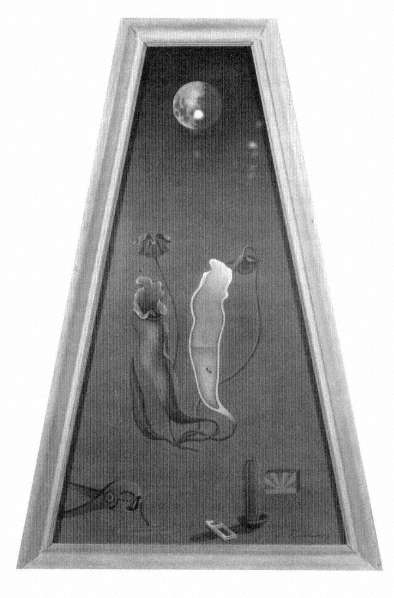
Figure 67
Above: Helen Lundeberg, Cosmicide , 1935. Oil on Masonite, 40 × 24 in.
NAA-Gift of the Peter Kiewit Foundation, Sheldon Memorial Art Gallery,
University of Nebraska-Lincoln.
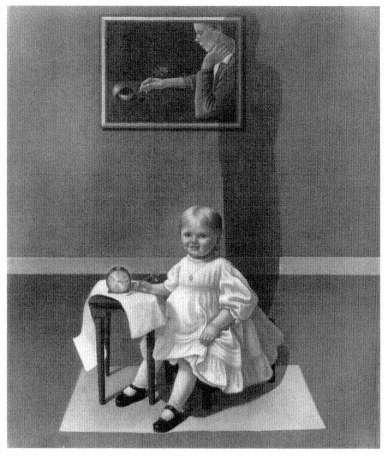
Figure 68
Helen Lundeberg, Double Portrait of the Artist in Time ,
1935. Oil on fiberboard, 47¾ × 40 in. National Museum of
American Art, Smithsonian Institution, museum purchase.
For the portrait of myself as a child I used a photograph which I still have, and though the props are a little different in the painting from the photograph, the pose is pretty much exact. I also used the clock to show that it was a quarter past two which corresponds to the child's age. And instead of presenting myself as an adult before a painting of myself as a child, in Double Portrait in Time I reversed this possibility where the child casts a shadow which is that of an adult who appears in the portrait on the wall.[11]
Another of the Post-Surrealists to achieve national distinction was the Danish artist Knud Merrild, who arrived in Los Angeles in 1923. Progressive in art as well as politics, Merrild was attuned to advanced European modernism and quickly found himself at the center of the art scene in Los Angeles. Man Ray and the writer Henry Miller were close friends of his, and he was one of the few American artists collected by Walter and Louise Arensberg.
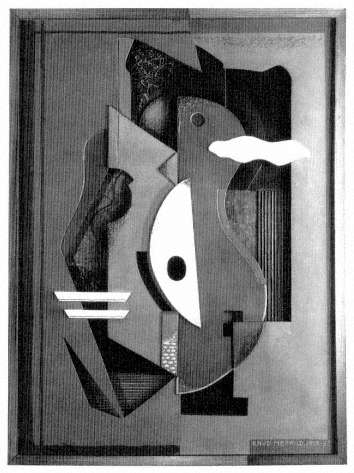
Figure 69
Knud Merrild, Aesthetic Function in Space , 1928-33. Painted wood
construction with painted cutouts of Masonite, painted corrugated
cardboard, and silvered metal, 31 × 22 ¾ in. Private collection.
Photograph courtesy, Steve Turner Gallery, Los Angeles.
In the 1930s Merrild made surrealist paintings and collages as well as relief constructions (some of the earliest assemblages to come out of the region), which owed a debt to Ernst, Kurt Schwitters, and organic surrealism (Fig. 69).[12] His collage Alpha and Omega (1935; Fig. 70) is related formally and thematically to Lundeberg's shaped canvas Cosmicide and Feitelson's 1936 shaped collage-painting Life Begins (Fig. 71), expressing the natural law of regeneration: "a cycle of desire, impregnation, generation and birth."[13] It illustrates the artistic borrowings and interactions common among early Los Angeles modernists.
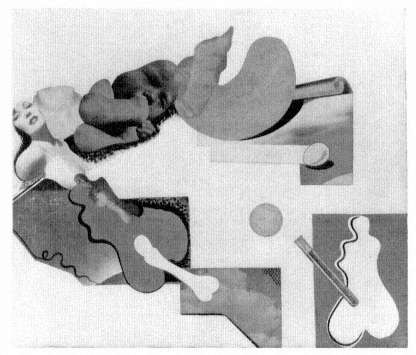
Figure 70
Above: Knud Merrild, Alpha and Omega , 1935. Collage: oil cloth, paper,
magazine and newspaper cutouts, and ink drawing on board, 23 ¼ × 29 ¾ in.
Photograph courtesy Steve Turner Gallery, Los Angeles.
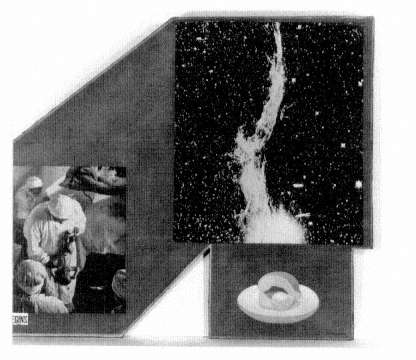
Figure 71
Left: Lorser Feitelson, Life Begins , 1936. Oil and photocollage on Masonite,
22 ½ × 26 ½ in. Photograph courtesy Tobey C. Moss Gallery, Los Angeles.
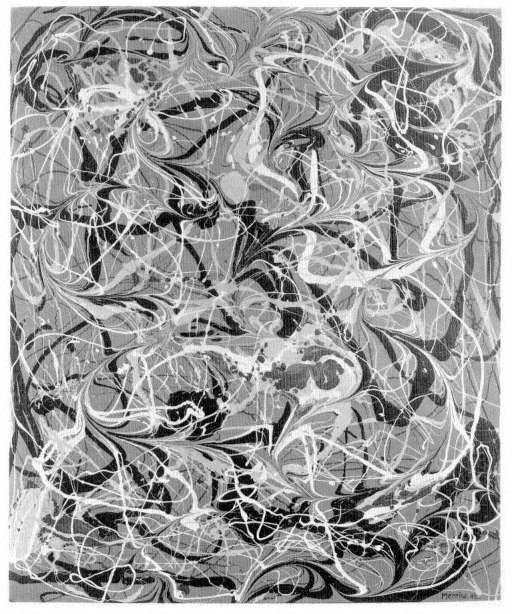
Figure 72
Knud Merrild, Perpetual Possibility , 1942. Enamel on composition
board, mounted on plywood, 20 × 16 1/8 in. The Museum
of Modern Art, New York, gift of Mrs. Knud Merrild.
In the early 1940s Merrild experimented with surrealist automatism, exploring the fortuitous and the unforeseen in his flux paintings. In works such as Perpetual Possibility (1942; Fig. 72) Merrild pooled and dripped house paint onto a fluid surface, which he then tipped, running the colors together to create unexpected effects. These paintings are reminiscent of Onslow-Ford's coulages of 1939 and Pollock's drip paintings of five years later. As Jules Langsner eloquently stated, "The impetus to invention came from the necessity to give form to a considered view of existence. For Merrild, that view was rooted in his belief in the life-giving properties of chance, of growth, of discovery, of susceptibility to that which is new, untapped, of one's own time."[14]
Other artists who periodically exhibited with the Post-Surrealists were students of Feitelson's: Philip Guston (then Goldstein) and Reuben Kadish, who together painted a 1937 fresco for the Los Angeles Tubercular Sanitorium at the City of Hope under Feitelson's supervision.[15] The fresco, which takes alchemy as its subject matter, was one of the few murals completed for the Works Progress Administration (WPA) in Southern California that shows any modernist experimentation at all. Guston and Kadish were also politically active, later becoming members of the American Artists Congress, which provided a forum for leftist political ideas.[16] Even so, Bretonian surrealism, which sought the transformation of social structures through revolution, was far more political and leftist-oriented than Post-Surrealism.[17]
"DADA of Us All": Man Ray in Hollywood
While we have become accustomed to the noir image of 1940s Los Angeles in the literature of such writers as Raymond Chandler, it is clear that there was another side to the story. Recalling his days in Hollywood, Man Ray said:
It was like some place in the South of France with its palm-bordered streets and low stucco dwellings. Somewhat more prim, less rambling, but at the same time radiant sunshine ... one might retire here, I thought, live and work quietly—why go any farther ... I had a wonderful time, this was the first time in my life when I really felt like I was on vacation.[18]
Man Ray, a founder of New York dada and a central figure in the Paris surrealist group, lived from 1940 to 1951 in Los Angeles, where the artist-dealer William Copley called him "the DADA of us all."[19] Although an American, Man Ray was, in many ways, as much an expatriate on these shores as Ernst and Breton. After escaping occupied France in 1940, he drove across the United States and took up residence on Vine Street, opposite the "All Night" Ranch Market. In 1946 he married the dancer Juliet Browner in a double wedding with Max Ernst and the painter Dorothea Tanning. Walter and Louise Arensberg gave them a reception in their Hollywood home. Ernst painted Double Wedding at Beverly Hills to commemorate the event.[20]
Man Ray was born in Philadelphia in 1890 as Emmanuel Rudnitsky. At the age of twenty-five he met Marcel Duchamp and Francis Picabia in New York, two years after Duchamp's painting Nude Descending a Staircase, No. 2 caused an uproar at the Armory Show. As friends, he and Duchamp directed the course of New York dada and founded the avant-garde art group Société Anonyme. When Man Ray went to Paris for the first time, in 1921, he was immediately accepted by the group that would later call themselves the surrealists.
Man Ray was extremely prolific in Los Angeles, producing there in ten years more paintings, objects, photographs, and his trademark Rayographs—many of them elaborations of former work—than he had in the prior thirty. Night Sun—Abandoned Playground (1943) is a disquieting narrative, a fusion of his favorite earlier themes with recent events in his California life, alluding to his difficult passage to the United States from occupied Europe. The painting contains typically western images such as a sun setting over the ocean, a white beach, and a cypress tree, but the tree has toppled against a Spanish-style bungalow, apparently the artist's own home. The molecules floating inside the house no doubt refer to Man Ray's neighbor, the Nobel Prize-winning chemist Linus Pauling.[21] Molecular arrangements also appear in other works from this period, such as the collage Optical Longings and Illusions (1943).
Man Ray exhibited his Los Angeles production of surrealist objects, or assemblages in the spirit of readymades, in a 1948 exhibition at the Copley Galleries. These "Objects of My Affection," as the artist called them, were notable examples of the crossover between popular culture and high art in Los Angeles, a form of proto-pop art. His Optical Hopes and Illusions (1944), a mixed-media object composed of a found banjo frame, ball, and mirror, is an ominous toy that makes no sound, referring to Man Ray's thwarted artistic aspirations and the fantasyland of Hollywood.[22]
La Fortune, III (1946), an assemblage composed of a wheel of fortune and a roll of toilet tissue affixed to an upright plank, similarly implied a wiping away of deceit and decay, a scrubbing clean of social veneers. This piece evoked the surrealist "penchant for chance, for the objet trouvé, and for the double entendre."[23]
In his work Man Ray constructed a dada/surrealist metaphor of the ambiguous relationship between the real and the fictive, making reference to the uncertain nature of Hollywood culture and its destinies. He was one of the few artists of the time to respond to Hollywood so directly in his work and perhaps one of the first to address the dark side of the Sunshine Muse.[24]
Man Ray exhibited and lectured extensively on the West Coast (even broadcasting lectures over the radio) beginning in the mid-1940s,[25] but he considered the 1948 exhibition at the Copley Galleries the high point of his sojourn in California. For the opening, the gallery created a Paris café atmosphere. The list of guests gives an idea of the notable artists, musicians, and film people in his circle: Josef yon Sternberg, Edward G. Robinson, Harpo Marx, Fanny Brice, Lorser Feitelson, Helen Lundeberg, Peter Krasnow, George Biddle, Hans Hofmann, Isamu Noguchi, Eugene Berman, Robert,)
Matta, Knud Merrild, Max Ernst, Dorothea Tanning, Igor Stravinsky, Aldous Huxley, Bertolt Brecht, Thomas Mann, Henry Miller, Luis Buñuel, Jean Renoir, and Otto Preminger.[26]
In addition to his objects and assemblages, Man Ray also exhibited a series of paintings, the Shakespearian Equations , derived from his 1930s photographs of the constructions illustrating algebraic equations in the Poincaré Institute in Paris. These spare depictions, which may have opened the way for abstraction in California, are particularly evocative of Lorser Feitelson's Magical Forms series of roughly the same date.
Journey into the Body: The Art of Charles Howard
In his painting The Progenitors (1947; Plate 10), Charles Howard organized his shapes in rhythmic chains extending over the entire field, with pockets of deep space opening up in the midst of them. These metallic forms from an inner biological realm are bound together as if the system were tentatively structured, not as a matter of function, but as the result of some terrible, cosmic mistake. This painting, which simultaneously expresses chaos and biological limitation, also hints at the possibility of a new order. In Howard's art everything has the power to become something else. It is this sense of potential or transformation that binds his art to that of the surrealists and of Miró.
Howard's art, which incorporated unconscious elements and exploited the automatist approach—though in a restrained manner—declared "very explicitly a balance between reasoned construction and free intuition."[27] His surrealism shared the abstract formalism of the work of Jean Arp and Alexander Calder, which favored the traditions of cubism, constructivism, and De Stijl. Howard achieved an extraordinary fusion of two opposing forces in his work, the one rational and obsessed with order, the other exploring chaos and the depths of the unconscious. It was from this dialectic that, according to surrealist belief and imagery, alternative possibilities emerge.[28]
Howard, an American expatriate who returned to San Francisco from London at the outbreak of World War II, was raised in the Bay Area.[29] In 1932 Julian Levy had presented Howard's work in the groundbreaking exhibition that introduced European surrealism to the United States. He had included only three Americans: Howard, Man Ray, and Joseph Cornell. The following year Howard moved to London, where he was active with the London surrealists from 1936 to 1938.
Though Howard's work shares surrealism's obsession with unconscious material, it is related more to the biological patterns of bodily growth and decay than to the psychological world of dreams. Howard's paintings, which inspire the dim remembrance of primordial experiences such as the moment of birth or a premonition of death, also inspire a feeling of awe arising from heightened awareness of the sensing and feeling self.
This sense of inner sublimity connects Howard's work to traditions in eighteenth-and nineteenth-century English painting.[30] A special state akin to the "marvelous" of
the surrealists, the sublime also contributes to a feeling of awe before the infinite, conveyed in Howard's work.
Movement was also a central concern of the artist. Like his lifelong friend Calder, Howard founded an art that exploited a "kind of mechanistic motion in space which grows inevitably from modern urban life."[31] Yet Howard was restrained in the employment of motion, and the dialectical nature of his art is here most apparent: he created primarily static constructions in which certain forms introduced a subtle sense of movement; in this his work shares much with the paintings of Kandinsky. In other works, Howard created a feeling of intense stillness that seemingly forebodes cataclysmic change. His paintings speak of time suspended, or a sense of déjà vu reflecting the political climate of the World War II era.[32]
Howard went through an artistic catharsis during the early blitzes in London, and his work took on a darker, more emotional quality, became more tense and dramatic. One critic compared his approach then to that of the artist Paul Nash, "who developed a kind of 'found-object' art out of the shapes of shattered buildings and splintered Messerschmitts."[33] In First War Winter , 1939-40 (which Howard completed in San Francisco), there is an explosion of forms, as if an architectural structure were composed of parts on the verge of collapse. Narrow filaments sag toward the center of the composition, creating the impression that everything is being sucked into a vortex.
In 1940 Howard left the chaos of wartime England and moved back to San Francisco, where his work was immediately well received by local critics and the director of the San Francisco Museum of Art, Grace McCann Morley. He acted as designing supervisor of the WPA and in 1945 took part in a lecture series on surrealism at the California School of Fine Arts that included Salvador Dalí, Man Ray, and the surrealist poet Georges Lemaître.[34]
During the war, Howard worked in a shipyard, where the symmetry of ship construction engaged him and where scrap piles provided him with streamlined forms and accidental twists of metal. He also spent hours in the library looking at books on biology. His work began to incorporate a greater sense of the biological and of the metallic and also revealed his increased interest in multispatial arrangements, though he retained an essentially flat two-dimensional space by exploiting the ambiguity of figure and ground.
The First Hypothesis (1946; Fig. 73) was completed shortly before Howard returned to live permanently in England. In it hairlike filaments spill out of an "organ" encased in other forms and positioned along a central axis or totem-pillar. A single, bladelike form protrudes into our space. Reminiscent of the symbol of infinity, it refers to the unknown, or to expansive infinite space and alternative possibilities, ideas implicit in Howard's mature work. As Howard's most eloquent critic, Douglas MacAgy, wrote:
The abyss is a recurrent motif in the arts. It has inspired a range of responses from curiosity through wonder, awe, fear and dread. This abyss, with its origin of light obscured and its illumination lost in a periphery of darkness, may be claimed to present the unknown as a
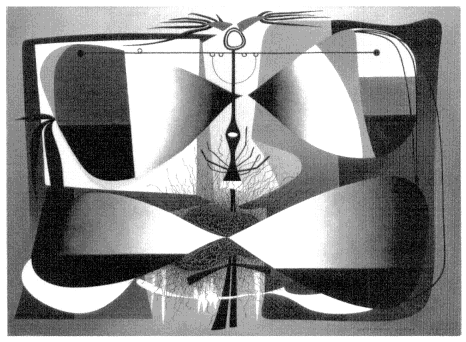
Figure 73
Charles Howard, The First Hypothesis , 1946. Oil on canvas,
16 ¼ × 22 1/8 in. The Menil Collection, Houston. Photograph by Paul Hester.
hidden power. Stability is threatened: projected movement into it might be endless and timeless. To become absorbed by it could mean that dimensions might be transformed, and with the change, a measure of faith. This unknown may be unformed, but it cannot be called formless. In a word it is that archetype of the abyss—Chaos.[35]
Howard fashioned a visceral art in which abstract forms were a potent vehicle of the sublime. He was one of California's most prominent and influential artists during the war. Afterward, when he returned to England, he continued to develop his art, creating in the 1960s ever more austere visions that paired minimalist simplicity with a great complexity, expressing the primal struggle between order and chaos intrinsic to surrealism.[36]
Isle of Possibility: Gordon Onslow-Ford and the Dynaton
San Francisco, long a haven for nonconformists and eccentrics, was in the postwar period a mecca for artists, poets, and other members of a growing counterculture.[37] Here artists with modernist leanings developed a strong sense of community. San
Francisco was also a city poised, like all of California, "between the currents of the great old cultures of the Pacific and the stirring forces of America."[38] This openness to the cultures of Mexico and the Pacific Rim, and to the stream of international modernism, provided the catalyst for the Dynaton.
The Dynaton came into being in the late 1940s. Wolfgang Paalen had been brewing the postsurrealist experiment for five years in Mexico before moving to the Bay Area in 1948. As Lee Mullican recalled, "Paalen felt that there was an intellectual climate in San Francisco where something could really happen. The war had ended. We were all enthusiastic that ... this scene would be a growing center of culture. And the museum was sympathetic to what was happening."[39]
Some years earlier in France, prior to the outbreak of World War II, Gordon Onslow-Ford and the Chilean surrealist Roberto Matta had together developed the idea that the world of perception was only a section of a larger, invisible, order of existence in which everything was bound together into an indivisible whole.[40] When they joined André Breton's surrealist movement during its final phase in 1938, they had already developed their own approach to automatism, which had more to do with time and space than with Freud.[41] Together they reoriented the movement toward the more abstract and automatic foundation from which it had arisen in the early 1920s. This later form of abstract surrealism, which was so influential in the United States in the early 1940s, was more concerned with ideas about higher dimensions and with exploration of a fluid time-space continuum than the earlier version had been. Although surrealism is usually associated with the studies of Freud, it is clear that art at this time developed out of a matrix of influences and ideas, and that later surrealism owed as much to concepts about space and the fourth dimension as it did to psychology.[42]
When he arrived in the United States in 1941, Onslow-Ford became distinguished as surrealism's chief spokesman in the country until Breton came later that year. Onslow-Ford gave the first significant series of lectures on surrealism in the United States, at the New School for Social Research. Along with Howard Putzel, he also organized chronological exhibitions to accompany these lectures. Onslow-Ford was key to the assimilation of surrealist methodology and thought in the years when American art was coming of age.[43]
In 1941 Onslow-Ford went to Mexico, where the Austrian surrealist Wolfgang Paalen had moved two years earlier at the invitation of Diego Rivera and Frida Kahlo. Paalen's reputation had been established in 1936 in Paris, and he was one of the organizers of the Paris International Surrealist Exhibition in 1938, the year he met Gordon Onslow-Ford at the Café Deux Magots. Paalen's real contribution to international art came in Mexico, however, where he was inspired by the primal spirit of native American arts, the new physics, and the thought of John Dewey. In 1940 he helped Breton organize an international surrealist exhibition there.[44]
In Mexico Paalen published Dyn , one of the most avant-garde art journals flourishing internationally during the war. This interdisciplinary (mainly English-language)
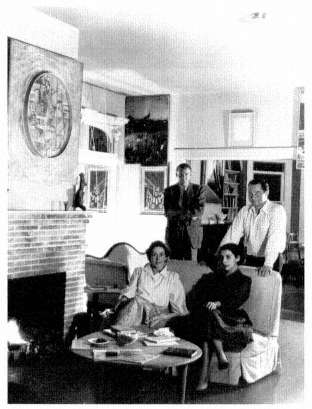
Figure 74
Clockwise from top left : Lee Mullican, Cordon Onslow-Ford,
Luchita Hurtado, and Jacqueline Johnson in the San
Francisco home of Onslow-Ford and Johnson, ca. 1951.
Harry Bowden papers, Archives of American Art,
Smithsonian Institution.
review of art, archaeology, and science circulated theoretical and critical essays as well as illustrations of contemporary masters like Picasso and Henry Moore, and the emerging Robert Motherwell and Jackson Pollock. It especially focused on the native arts of the Americas and on art theory, advancing "an open-ended approach to art based on creativity's boundless potential."[45] Paalen saw automatism as a source of raw material for the artist but not as an end in itself. He published his "Farewell to Surrealism" in the first issue; Onslow-Ford, after officially resigning from the movement in 1943, contributed to the final issue. Dyn had a significant impact on expatriated European artists in the United States as well as the emergent New York School. During the war years it led many artists into surrealist phases, including Lee Mullican in 1943. Others with whom Paalen and Onslow-Ford were in close contact in Mexico were Motherwell and Matta. Motherwell recalled that "what we did ... as then-isolated Western intellectuals in Mexico, was to encourage each other in our various aspirations and with our various bits of knowledge."[46]
Onslow-Ford moved to the San Francisco Bay Area permanently in 1947, taking with him a formidable collection of twentieth-century modernist and pre-Columbian art (Fig. 74). He had a major retrospective at the San Francisco Museum of Art in 1948,
accompanied by the publication of his book Towards a New Subject in Painting . Lee Mullican returned from military duty, and Paalen also moved to the Bay Area in the late 1940s, where each had a retrospective at the San Francisco Museum of Art.
Paalen, Onslow-Ford, and Mullican soon discovered they shared common aims, and in 1949 they lived together for a few months in Paalen's Mill Valley house. In 1950 the artists exhibited together at Stanford University, with lectures by Sybil Moholy-Nagy, Onslow-Ford, and Paalen. Soon thereafter the artists were shown again, this time at the San Francisco Museum of Art in an exhibition they called the Dynaton .[47] In one of his two essays for the exhibition catalogue, Paalen wrote:
Our images are not meant to shock nor to relax; they are neither objects for mere aesthetic satisfaction nor for visual experimentation. Our pictures are objects for that active meditation which does not mean detachment from human purpose, but a state of self-transcending awareness, which is not an escape from reality, because it is an intuitive participation in the formative potentialities of reality.[48]
According to the group, the Dynaton (from a Greek word meaning "the possible") was a transformative art, a fusion of the artists' interests in pre-Columbian and native American cultures, shamanism, non-Western philosophies such as Zen Buddhism, the new physics (particularly wave-particle theory), and extraterrestrial life, all in an essentially meditative framework. The artists of the Dynaton espoused the principles of European surrealism—automatism and the primacy of the unconscious—and the vital quiet in California nature as their points of departure.
Nature was essential to the Dynaton. Paalen poetically referred to the work of each artist in terms of the four elements. "For Gordon the element is water and all it hides and bares, the moon, the neckline of the figurehead and the breath in the shell.... Air is the element for Lee, and all it carries, pollen, feathers, the dreams of birds and spikes of stars and the holy nest of winds ... the ray of sun on the straw." Paalen referred to himself as "the fire, the places where the devil cooks his ware."[49]
Onslow-Ford's Dynaton paintings radiate a sense of the artist's preternatural intimacy with nature. In A Stone That Dreamed (1950; Fig. 75) a vertical surface grid of broken color creates a screen through which pulsating dots subtly move. It is as though reality were coming into focus from behind a veil of illusion. Viewers, actively meditating, situate themselves in the kinetic space of the painting.[50]
According to Mullican, the Dynaton now floats in his memory "as a softened sun."[51] His mandala-like paintings (Fig. 76), reflective of the West's wide-open spaces and possibility for intimacy with nature, invited contemplation. Capturing the essence of vast expanses of sea, land, and sky, Mullican contributed "the sunlit fields and refractions of the West" to the aesthetic of the Dynaton.[52]
Soon after the 1951 San Francisco exhibition, the group disbanded. Paalen returned
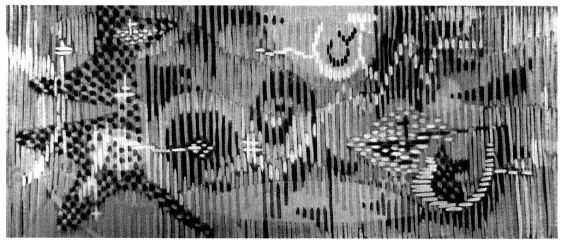
Figure 75
Above Gordon Onslow-Ford. A Stone That Dreamed , 1950. Casein on paper
mounted on board, 36 × 85 in. Collection of the artist, Inverness, California
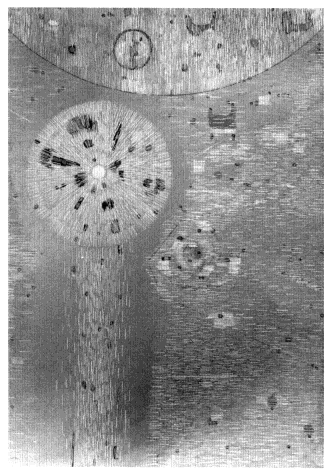
Figure 76
Left: Lee Mullican, Peyote Candle , 1951. Oil on canvas,
50 × 35 in Collection of the artist, Santa Monica, California.
to Mexico and Mullican moved to the Los Angeles area, where he has lived ever since, spending much time in New Mexico as well. Onslow-Ford moved to Mill Valley and later Inverness, where he now resides.
In retrospect, Onslow-Ford feels his contribution to art was only just beginning at the time of the Dynaton exhibition. Six months later he discovered a more direct expression of the deep structures of the mind in what he called line/circle/dot. It was then he felt he had discovered the root of all things and "the depths from which things grow."[53]
Both Onslow-Ford and Mullican (who also feels his own Dynaton paintings belong to a formative stage of his art) still find inspiration in their early breakthroughs with Paalen in San Francisco. The Dynaton artists, in addition to exhibiting an interest in native American culture and meditative states of consciousness, integrated Eastern philosophies into their art, thus exemplifying an early openness to Asian culture. This openness has been a continuing influence on American art and culture since the 1960s, but for an even longer time it has been intrinsic to the art of California, because of the state's location on the Pacific Rim.[54]
Conclusions and Consequences of Surrealism
Surrealist expression in California emerged during the 1930s and 1940s from audacious experimentation and innovation at the boundaries of art forms and genres. Surrealism proved an experimental art that could be exported anywhere, taken up by others and mixed with local cultural possibilities. California artists tinkered with the international model and gave surrealism new meaning.
Surrealism is an art of internal experience and its transformation into a profound form of self-portraiture. Surrealist-inspired California art revealed the artist's encounter with the inner and outer world during a period in U.S. history when traditional certainties, boundaries, and identities were thrown into question.
Although the history of surrealism in California is inextricably tied to the depression and the events of World War II, common experiences of these crises are not always directly visible in the work of California artists. Diverse and individual expressions arose in California art during the 1930s and 1940s; their inner similarities are as striking as their formal differences. Connecting much of the work are metaphors for "interconnectedness," "potential for change," "vastness," "restriction," "elasticity in relationship to space," "dialectic between presence and absence," "the ambiguous relationship between the real and the fictive," and "the fictional nature of the culture." Some of these metaphors are those of modernist art as a whole. Others are more specifically related to California modernism and seemingly point toward a postmodern aesthetic.[55]
It was not surprising that surrealism took early hold in Los Angeles, where Hollywood movie lots often spill out into city streets. Los Angeles was surrealist by nature. Artists then, as now, could hardly evade the effects of this popular culture—a creative
force continuously reinventing itself—on their art.[56] The link between surrealist art and the popular culture of the film industry in the region was articulated as early as 1934 by the San Francisco critic and artist Glenn Wessels, who reviewed a Max Ernst exhibition at the Paul Elder Gallery: "Ernst speaks from that half-world, the subconscious, the world of dreams, the Mickey Mouse world . . . where 'almost anything is more than liable to happen.'"[57]
California surrealist expression developed outside the mainstream of modern art, in the freedom of the western frontier. The frontier lies physically and metaphorically far from artistic rules and institutional strictures, tradition, and imposed ideas. It encourages inwardness, individuality, reflection. Much of California art exhibits an obsession with the natural landscape, its light and space. Post-Surrealism, for example, evoked a sense of freedom, contemplation, and peacefulness that can be attributed to the geographic and climatic conditions of the Pacific coast. Nonetheless, it was not merely a local Los Angeles expression; its concepts were universal. Even so, the work cannot be accommodated in the framework of "international surrealist art," because its focus and priorities were radically different. It exemplifies the inevitable meeting and clashing of cultures, ideologies, and artistic styles that contribute to the stylistic eclecticism or pluralism characterizing much of California modernist art.[58]
A closer study of Man Ray's Los Angeles period and his influence on regional artists is still called for. His work was an anticipation of pop art "in the meticulous rendering of ordinary things unexpectedly isolated for our contemplation—" though invested with an enigma lacking in pop art.[59] Man Ray's California output contributed to the emergence of pop art, because it may have directly influenced the proto-pop expression of artists like Jess, who was living in Southern California and actively visiting galleries at the time.
Clearly in melding European surrealism and the popular culture of Los Angeles Man Ray helped define a regional propensity for creating art that achieved a crossover between popular culture and high art. He also brought to light the Southern California inclination to mix fantasy and the real. To harbor such opposites while simultaneously dissolving the barriers that distinguish them is a feature intrinsic to surrealism, as well as to postmodernist theory. Equally, his Rayographs and other photographic work initiated a special role for photography in regional art, beginning in the 1960s with the artists Wallace Berman and George Herms and including diverse others such as Robert Heinecken and John Baldessari. Man Ray contributed to the strain of Los Angeles art that understood the potential of the photograph-as-object and endorsed photography as a serious element of the art lexicon long before the New York postmodernist work of the artists Sherrie Levine, Richard Prince, Cindy Sherman, or others in the 1980s.[60]
Changes were also visible in the art of Lorser Feitelson beginning in the early 1940s, changes that must have been due to the wartime climate and the influx of refugees from Europe, especially Charles Howard and Man Ray. Feitelson developed his Post-Surrealism until about 1942, when his art went through a transformation and began to
reflect "the realization that certain kinds of events unexpectedly take one beyond the usual way of experiencing things."[61] In this new work, Feitelson developed surrealist abstractions in which he sought to "invent 'magical forms' at once tangible and without parallel in memory, concrete and freighted with interior sensation."[62] Thereafter he developed a spatially ambiguous art in which form and ground were indivisible, and in which shape was preeminent and wholly enigmatic, merely evocative of natural forms.
By 1950 Feitelson had become an exponent of the abstraction termed hard-edge, or abstract classicism, along with the artists John McLaughlin, Karl Benjamin, and Frederick Hammersley. While in Northern California surrealism developed toward abstract expressionism, in Southern California it developed toward geometric abstraction. Like Post-Surrealism, abstract classicism evoked a contemplative peace based in local environmental conditions and the artists' conscious absorption of Eastern philosophies. At the same time, it conveyed a sense of movement, tension, or "slippage" that expresses the mobility and artificiality of Southern California culture, thus embodying at once the two directions visible in contemporary Los Angeles art. Abstract classicism anticipated the Los Angeles finish fetish of the 1960s and the light-and-space art of the 1970s and prefigured the important artistic impulse minimalism.[63]
In the San Francisco Bay Area in the 1940s, artists were exposed to surrealism primarily through the work of Charles Howard, Dorr Bothwell, Jean Varda, Clay Spohn, Stanley William Hayter, Mark Rothko, and the artists of the Dynaton group. It is doubtful whether those artists who championed abstract expressionism, especially at the California School of Fine Arts, would have been so open to the new gestural, abstract idiom without previous exposure to surrealist principles. At any rate, their interest in surrealism waned around 1948, in part because of their exposure to the anti-surrealist sentiments of Clyfford Still.[64]
Still's distaste for surrealist automatism was endemic during the late 1940s. The San Francisco school of abstract expressionism rejected myth-conferring titles and symbols, and its work rarely showed such surrealist commonplaces as swirling arabesques and curvilinear shapes. Moreover, because automatism was not fundamental to the painting process, the work produced was somewhat less linear and gestural than abstract expressionism in New York, more "rugged and earthy."[65]
While surrealist automatism was being discouraged at the California School of Fine Arts, it was invigorating an underground scene in the Bay Area and in Los Angeles that would coalesce into the Beat generation expression of artists like Wallace Berman, George Herms, Gordon Wagner, Jay DeFeo, and Bruce Conner. The Dynaton, a conceptual rather than a perceptual art, provided a bridge between the interest in surface of the San Francisco school of abstract expressionism and the content-driven art of the Beats.
The Dynaton's use of themes and motifs inspired by non-Western art forms and primitive art, its interest in the new science and extraterrestrial life, its allusions to Zen as well as its unorthodox approaches and anti-establishment attitudes paralleled the
interests of the post-Still generation: Asian philosophy, esotericism, Mexican culture, the nonrational, jazz culture, Alan Watts, and Jungian psychology. The Dynaton helped set the tone for much of the art of Northern California in the 1950s, contributing to the emergence of Beat and funk art. Onslow-Ford, Paalen, and especilly Mullican were connected with the underground activity that had begun in San Francisco in the early 1940s.
One of the earliest and most important manifestations of this counterculture was in experimental film. James Broughton and Sidney Peterson, who produced a surrealist fantasy, The Potted Psalm , and Frank Stauffacher, who initiated the Art in Cinema series at the San Francisco Museum of Art, were close friends of the Dynaton artists.[66] Surrealist automatist calligraphy is also visible in the 1950s work of several of the artists who exhibited at the Six Gallery, the focal point for Beat-era artists and poets from 1954 to 1957.[67] Five of the six artists who started the gallery had drifted up from Los Angeles, following the promise of an active and close-knit art community.[68]
The impulse to merge genres and to eliminate traditional boundaries between art forms grew equally out of the dada and surrealism of the artists Knud Merrild, Max Ernst, and Man Ray, who exhibited in Southern California widely during the late 1940s. What emerges from this picture is an untidy but vigorous history of cross-pollinations and complex interconnections. European surrealism has had a powerful influence on the art of California, from the abstract expressionism of the 1940s and the assemblage of the 1950s and 1960s to contemporary expressions.